Postcards from Italy
As is often the case, it's been months since I took the trip that I describe below. In fact, I had almost decided I wouldn't write about it at all until I found out that TinyLetter would be shutting down in February 2024. So I am writing this as my final entry on this platform... though surely not my last travelogue.
****************
ROME: April 15-19
I have been to Rome five times since 2001 and have even declared it "the greatest city on earth" now and again but have never written a thing about it. And so I will now. Oya, Julia and I arrived on a Saturday afternoon. Our digs were in near Piazza Navona, on a little street called Via dell Orso. The building seemed to be from the XVIth century at the very newest, with massive half-timber crossbeams on the ceiling, but was decorated so strangely that it couldn't be said to have "atmosphere." The highlight of the strange decor was an oil painting at least 12' by 5' of the duchess of someplace, just above our bed, who stared out at the room with with either disdain or a toothache. Our street was wonderful, though. Each morning I set out to find us coffee, a juice and some pastries. There was a bar-cafe just down our street, and I would always arrive while the old men in the neighborhood were talking to the barista over an espresso. We were also just one street back from the Tiber, and I got in the habit of walking out and looking at the river in the morning and filling our water bottles at one of those brass spigots you find all over Rome, on the alley that led from our street to the riverwalk, before returning home.
Most of our four days was spent outdoors, even though it rained half the time. Our first day we went to Piazza Navona and showed Julia the Quattro Fiumi fountain. We wandered over to the Pantheon and took a look inside. We had pizza and Aperol spritzes with homemade aperitivi in Campo di Fiori, just as the flowersellers were packing up for the evening, utterly happy to be there.
One of the things about returning to a city you have visited before is the way a new visit to a familiar place seems to layer the new memories on top of the old ones. There is a restaurant Oya and I discovered more than a decade ago called La Gallina Bianca that we have returned to each time. We tend to order the same foods, including fiori di zucca (zucchini flowers stuffed with cheese and anchovies) and always finish the meal with limoncello, so that one visit is indistinguishable from each other. At the same time, I find that my experience of a city changes with age, with the amount of money in my pocket, with my priorities and with the limitations of traveling with a child.
In my usual fashion, I had been overly ambitious in my planning. I figured Julia was big enough that she could accompany us to museums on her own two feet (we had carried her when we visited in 2016), but when we got to Rome, it turned out you needed to have bought tickets for most places months in advance, and waiting in line for hours was out-of-the-question. We walked to St. Peter's and to the Colosseum and admired them from outside, but we didn't enter either. Even the Roman Forum, we looked at from the top of the Capitoline Hill but didn't descend into.
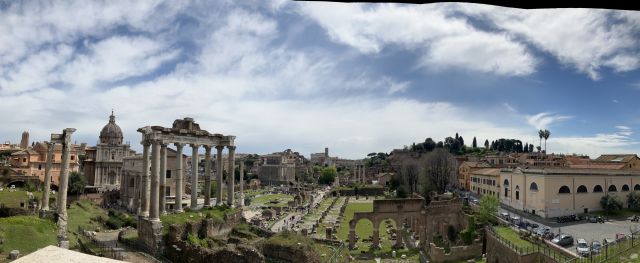
I still had a chance to see some artwork though. One of my goals had been to see a few of the Caravaggio paintings in churches in Rome, and two of the ones I wanted to see most turned out to be just a few minutes' walk from our door. The closest church, Sant' Agostino, houses the Madonna of Loreto, and the further one, Luigi dei Francesi, has The Calling of St. Matthew, which is so wonderful that I want to describe it in detail. It is within a chapel with two other paintings about the life of St. Matthew, all by Caravaggio, but this one is so singular in composition, I couldn't stop looking at it. A group of men sit at a table, all dressed in Renaissance garb. Two of them are busy counting money and don't notice Jesus, who has arrived at the door. Of the others, two young boys look at him almost disinterestedly, while the figure in the middle, Matthew, points at himself in disbelief. There is a window near the top of the painting, and there is a slant of light coming from the top right corner of the canvas -- but it is not coming from the window. The painting is all dusky tones of brown and gray except for the slant of light and a few splashes of color on the men's shirts. I haven't spent so much time looking at one painting in years.
Our best day in Rome, we took a long walk to the Villa Borghese. We charted our walk so that we passed the Trevi Fountain and the Spanish Steps on the way. At the bottom of the Spanish Steps, directly to the right is the building where John Keats died. I had paid a visit to his room on the second floor on a previous visit, and this time, instead, I went into the Acqua di Parma boutique on the first floor of the same building and came out smelling like a 1920s gentleman. When we got up to the Villa Borghese (a massive park if you've never been, with the eponymous villa at the center of it), we walked down the long gravel paths that lead you to a little amusement park with carousels, where Julia took a ride. We bought a couple of panini and a beer from the beautiful kiosk called the Casina dell’Orologio next door, and sat on a park bench. Our whole time in Rome, I recognized the things that set the city apart from Istanbul (nothing new, of course), but this park was the most substantial for me: a green space easy to reach, open to everyone and planned out thoughtfully. We laid our jackets out in a field enclosed by trees and sat while Julia ran around and played. It was a sunny but windy day, and we must have spent a whole hour without moving from that spot, it was so perfect. When we did get up, we discovered a place where children were taking pony rides. We've never had much luck with ponies, but Julia chose the smallest one for herself and seemed confident. She got on, and everything started all right, but this particular pony, its owner told us, did not walk free of the cart it was attached to, and when the whole cart started moving, she quickly changed her mind and got off. Oh, well.
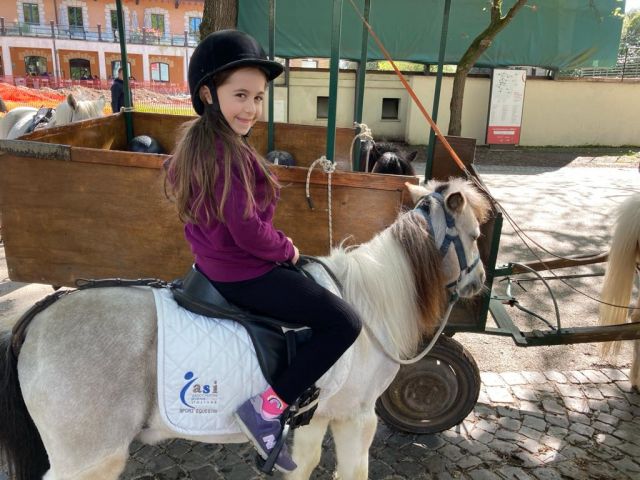
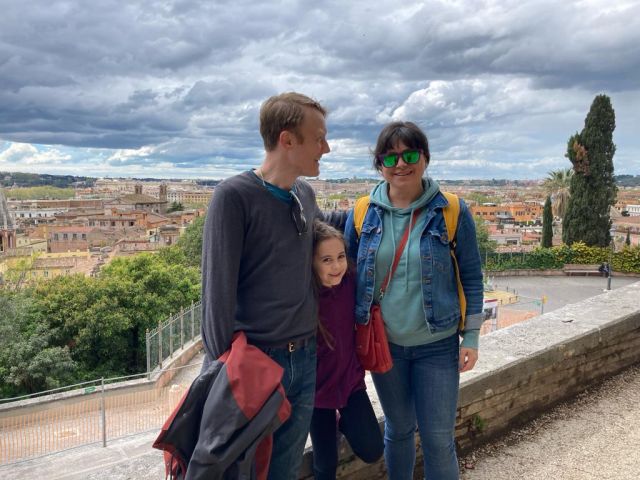
On our way back down into the city, we passed the Spanish Steps again and stopped at Caffè Greco, Rome's oldest cafe, which has been there since 1760 and has had the likes of everyone from Goethe onwards as patrons. I know I went there years ago, when I was in my 20s, but this was the first time with my family. We had a seat in a corner with a small red velvet bench at a green marble table, with photographs and oil paintings in golden frames hung overhead. I liked it so much that I told Oya I wanted a corner exactly like this in our next home. We were there just in time for happy hour and were served the fanciest cocktails I have ever seen and aperitivi served on a triple-decker cake stand, including the giant green castelvetrano olives that I love. We lingered there a long time, with no interest in being anywhere else. The interior of the cafe is as good as a museum, with the number of paintings on display -- but that much better since you can have a drink while you admire them! As twisty and convoluted as our morning path had been, it turned out we could walk all the way home on the perfectly straight Via della Fontanella di Borghese, which took us right to the entrance of the alley with the spigot where I filled our water each morning.
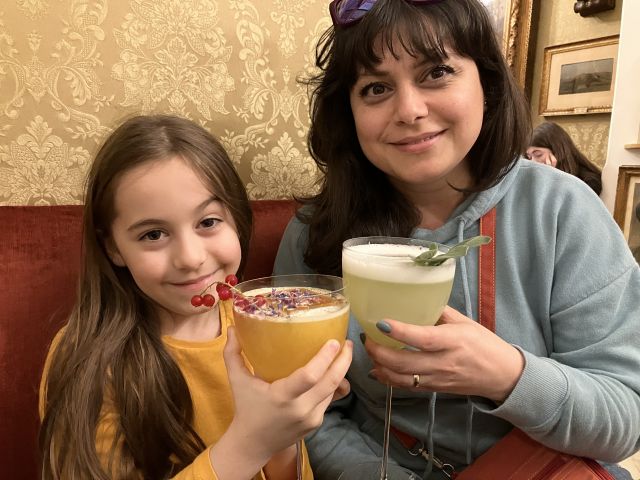
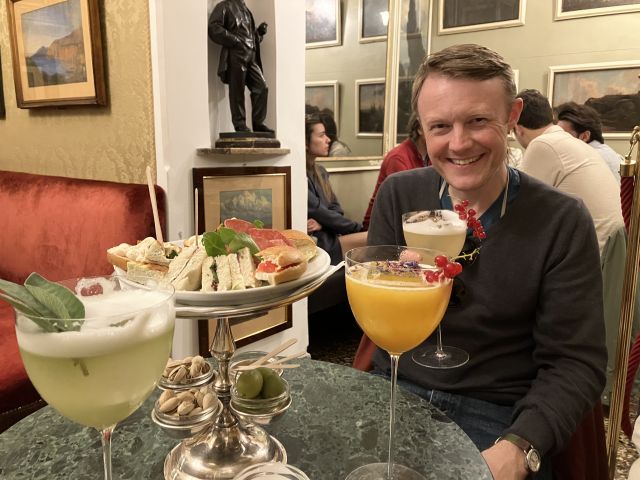
SORRENTO: April 19-22
The second leg of our journey took us south. We took the Rome to Naples train at noon, had a quick lunch in the train station, and then got on the Circumvesuviana train to Sorrento. It starts as a very urban train but soon gets out into the countryside, passing Mt. Vesuvius and the entrance to the ruins of Pompeii. My reason for going to Sorrento was that my dad and I had gone for his 70th birthday in 2015 and stayed in a villa overlooking the town that I had always wanted to return to. In fact, I wasn't all that crazy about Sorrento itself -- it had been a convenient place to stay to reach Naples, Pompeii and the temples at Paestum -- but the house alone was worth the visit. We were greeted at the train station by our host, Mario. He drove us up the winding hill and then down a long lane to his home, the Villa Parisi. The house is squarish and is easily recognizable from town. You enter through the largest door you've ever seen and then up a set of marble stairs. The tiles on the landings all seem loose and wiggle a bit beneath your feet. At the top of the stairs is a second door, opening on a long living-and-dining room that is as much stuck in a moment from the XIXth century as it seems lived-in. Our room or pair of adjoining rooms were off to one side. There were two massive wooden beds and an equally massive wardrobe full of funny hangers with poles attached that allowed you to hang and retrieve your clothes, since the hanging rod was so high. Best of all, however, was the view of Mt. Vesuvius and the Bay of Naples outside the window
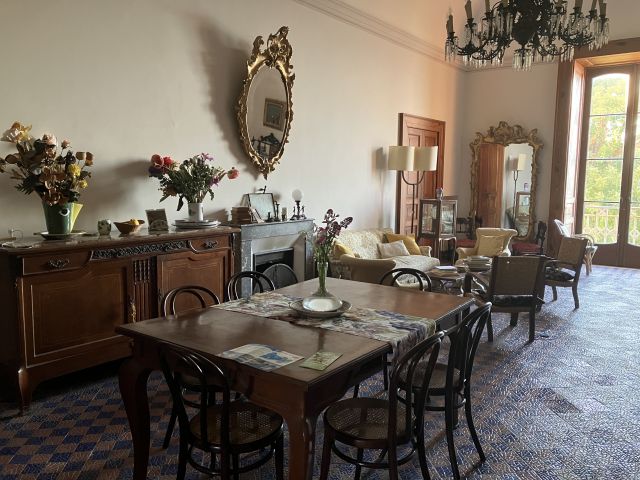
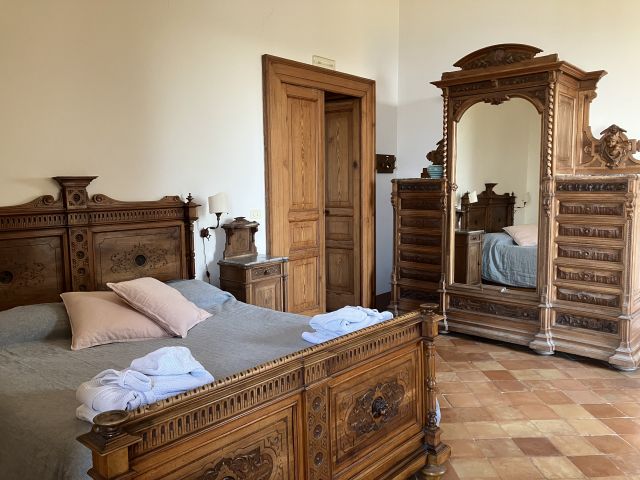
Again, I had been ambitious in my planning. I figured we would go to Pompeii one day and maybe take a boat to Capri another. Neither of these things happened. We walked down into Sorrento a couple of times and had the best seafood dinner I can remember in the beachfront area known as Marina Grande, which is reached through a series of narrow high-walled streets. Sorrento is famous for lemons, and we stocked up on the local limoncello and ate lemon sorbet served in scooped-out lemons as big as your head. But the best hours of each day were spent at the Villa Parisi. Mario prepared breakfast and coffee for us each day (I had been thinking about that coffee for eight years) and spent some time walking in the yard and looking at the view before heading into town. In the evenings we ha some olives and white wine and played the two Italian games we had picked up at a toy store in Rome. I started each morning reading the Autobiography of the XVIth century goldsmith Benvenuto Cellini in bed, which seemed to me the best place any person could hope to read such a book.
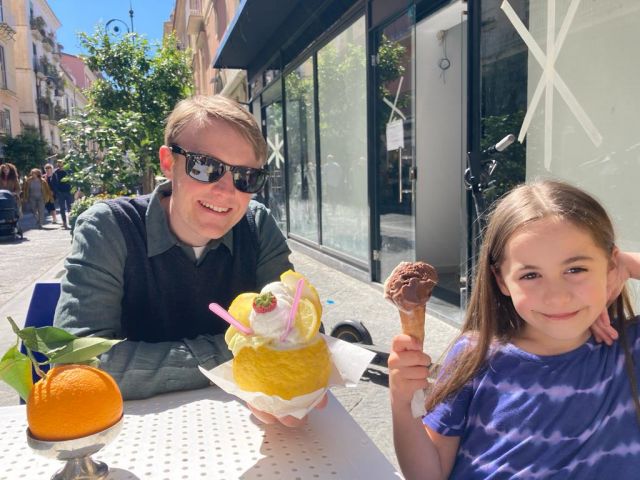
One day we decided not to go into town at all. Instead we walked up to the neighboring village, Priora, and had lunch at a place called Il Borgo, which has a view of all of Sorrento, plus the bay. It was a hot day, and after we walked back down to Mario's house, we played bocce in the yard for an hour. Julia asked me to play with her afterwards, and she invented the sort of game I would have played with my sister when I was a kid. The house is surrounded by an olive grove on the side with the view and a lemon orchard farther back on the property, and so we dodged between trees and climbed from terrace to terrace, chasing after something or being pursued by someone -- I let her make it up as we went. The grass had just been mowed, and the combination of the grass smell and the lemons and the heat of the day was heady and wonderful.
The day we departed, my plan was to spend the day in Naples. I had spent a day there before with my dad, before our own return to Istanbul, and the city had seemed mysterious and unlike any other place I had seen in Italy. We had been there on a Sunday, which had been as somnolent as Naples gets, and this time we would be there on a Saturday, when I figured more would be open. Most important, though, was eating some Neapolitan pizza.
We asked Mario, who grew up in Naples, what he recommended, and he said L'antica Pizzeria de Michele really couldn't be beat. This is the place I had seen videos of Rick Steves visiting, so I knew it would be crowded, but I didn't know how crowded. Naples made me nervous from the get-go, since the last time I had been there, two different pickpockets had opened my backpack before I could get from one side of the square outside Garibaldi train station to the other. This time nothing happened, but when we were looking for the pizzeria and asked a shopowner for directions, and he put his hand on my shoulder while he pointed the way, I had to check that he hadn't stolen my wallet, my passport and everything else. He hadn't, of course, but that was the frame of mind I was in. There wasn't a line outside the pizzeria but a throng. I got a number at the door, but there was a two-hour wait for the half-a-dozen tables inside. So Oya went up to order take-out. Julia and I waited for maybe 45 minutes before she reappeared with two pizzas and a beer. Now there was the question of where to sit. People were eating on the curb or in doorways. One had opened his pizza box on top of a trash can. A Brazilian couple told us there were some steps up the street where we could sit. The steps ran from the lower street to a higher one, between two buildings. We clearly weren't the first people to have this idea, as there were empty beer bottles everywhere, along with the remains of a fire someone had made the night before. We found a sheet of Visqueen that we covered two of the steps with and sat down. The pizza was out-of-this-world, but the fact that anyone who visited the most famous pizza place in Naples ended up eating on the street or on these steps between two run-down buildings with clothes hanging outside the window was bizarre to me. It was almost identical to the grimy streets in Tarlabaşı, not far from our house in Istanbul, only with great pizza.
I had already thrown out the idea of going to the Archaelogical Museum (which I had visited before) -- this, along with Pompeii and the rest of it would be saved for next time -- but was intent on visiting a few churches. We made our way up to the famous Via dei Tribunali, which I had loved on my previous visit. I wanted to see the statue of the Veiled Christ in the Sansevero Chapel, but again, you needed to buy tickets weeks in advance. I did stop into the Pio Monte della Misericordia, an octagonal church on the street, to see Caravaggio's Seven Works of Mercy, a particularly dark canvas with bits of human flesh and the wings of two angels in bright relief against the black of the background. But the Via dei Tribunali itself! Naples is so unbelievable gritty and un-worked-over. The white façades of the churches are stained with soot or grime or time itself. The streets are paved in black volcanic rock which must have come from Mt. Vesuvius, rubbed smooth under decades or centuries of footsteps. Every few steps on Tribunali was a little patisserie or salumeria or tiny restaurant with tables set up in the miniature courtyards between buildings. There isn't any space left unoccupied. Most of our time in the city was spent on this one street, which eventually led us down to the Duomo, with a baroque interior so opposite to everything going on outside, that I momentarily felt I was not in the same city.
When we flew out of Naples that evening, I looked back at the week, amazed at how full it felt, despite hardly doing anything in the sense that I would have thought of doing things in the past. It was still as enchanting as it had been when I had visited before, and there was no doubt in my mind that I would be back again before long.

****************
ROME: April 15-19
I have been to Rome five times since 2001 and have even declared it "the greatest city on earth" now and again but have never written a thing about it. And so I will now. Oya, Julia and I arrived on a Saturday afternoon. Our digs were in near Piazza Navona, on a little street called Via dell Orso. The building seemed to be from the XVIth century at the very newest, with massive half-timber crossbeams on the ceiling, but was decorated so strangely that it couldn't be said to have "atmosphere." The highlight of the strange decor was an oil painting at least 12' by 5' of the duchess of someplace, just above our bed, who stared out at the room with with either disdain or a toothache. Our street was wonderful, though. Each morning I set out to find us coffee, a juice and some pastries. There was a bar-cafe just down our street, and I would always arrive while the old men in the neighborhood were talking to the barista over an espresso. We were also just one street back from the Tiber, and I got in the habit of walking out and looking at the river in the morning and filling our water bottles at one of those brass spigots you find all over Rome, on the alley that led from our street to the riverwalk, before returning home.
Most of our four days was spent outdoors, even though it rained half the time. Our first day we went to Piazza Navona and showed Julia the Quattro Fiumi fountain. We wandered over to the Pantheon and took a look inside. We had pizza and Aperol spritzes with homemade aperitivi in Campo di Fiori, just as the flowersellers were packing up for the evening, utterly happy to be there.
One of the things about returning to a city you have visited before is the way a new visit to a familiar place seems to layer the new memories on top of the old ones. There is a restaurant Oya and I discovered more than a decade ago called La Gallina Bianca that we have returned to each time. We tend to order the same foods, including fiori di zucca (zucchini flowers stuffed with cheese and anchovies) and always finish the meal with limoncello, so that one visit is indistinguishable from each other. At the same time, I find that my experience of a city changes with age, with the amount of money in my pocket, with my priorities and with the limitations of traveling with a child.
In my usual fashion, I had been overly ambitious in my planning. I figured Julia was big enough that she could accompany us to museums on her own two feet (we had carried her when we visited in 2016), but when we got to Rome, it turned out you needed to have bought tickets for most places months in advance, and waiting in line for hours was out-of-the-question. We walked to St. Peter's and to the Colosseum and admired them from outside, but we didn't enter either. Even the Roman Forum, we looked at from the top of the Capitoline Hill but didn't descend into.

I still had a chance to see some artwork though. One of my goals had been to see a few of the Caravaggio paintings in churches in Rome, and two of the ones I wanted to see most turned out to be just a few minutes' walk from our door. The closest church, Sant' Agostino, houses the Madonna of Loreto, and the further one, Luigi dei Francesi, has The Calling of St. Matthew, which is so wonderful that I want to describe it in detail. It is within a chapel with two other paintings about the life of St. Matthew, all by Caravaggio, but this one is so singular in composition, I couldn't stop looking at it. A group of men sit at a table, all dressed in Renaissance garb. Two of them are busy counting money and don't notice Jesus, who has arrived at the door. Of the others, two young boys look at him almost disinterestedly, while the figure in the middle, Matthew, points at himself in disbelief. There is a window near the top of the painting, and there is a slant of light coming from the top right corner of the canvas -- but it is not coming from the window. The painting is all dusky tones of brown and gray except for the slant of light and a few splashes of color on the men's shirts. I haven't spent so much time looking at one painting in years.
Our best day in Rome, we took a long walk to the Villa Borghese. We charted our walk so that we passed the Trevi Fountain and the Spanish Steps on the way. At the bottom of the Spanish Steps, directly to the right is the building where John Keats died. I had paid a visit to his room on the second floor on a previous visit, and this time, instead, I went into the Acqua di Parma boutique on the first floor of the same building and came out smelling like a 1920s gentleman. When we got up to the Villa Borghese (a massive park if you've never been, with the eponymous villa at the center of it), we walked down the long gravel paths that lead you to a little amusement park with carousels, where Julia took a ride. We bought a couple of panini and a beer from the beautiful kiosk called the Casina dell’Orologio next door, and sat on a park bench. Our whole time in Rome, I recognized the things that set the city apart from Istanbul (nothing new, of course), but this park was the most substantial for me: a green space easy to reach, open to everyone and planned out thoughtfully. We laid our jackets out in a field enclosed by trees and sat while Julia ran around and played. It was a sunny but windy day, and we must have spent a whole hour without moving from that spot, it was so perfect. When we did get up, we discovered a place where children were taking pony rides. We've never had much luck with ponies, but Julia chose the smallest one for herself and seemed confident. She got on, and everything started all right, but this particular pony, its owner told us, did not walk free of the cart it was attached to, and when the whole cart started moving, she quickly changed her mind and got off. Oh, well.


On our way back down into the city, we passed the Spanish Steps again and stopped at Caffè Greco, Rome's oldest cafe, which has been there since 1760 and has had the likes of everyone from Goethe onwards as patrons. I know I went there years ago, when I was in my 20s, but this was the first time with my family. We had a seat in a corner with a small red velvet bench at a green marble table, with photographs and oil paintings in golden frames hung overhead. I liked it so much that I told Oya I wanted a corner exactly like this in our next home. We were there just in time for happy hour and were served the fanciest cocktails I have ever seen and aperitivi served on a triple-decker cake stand, including the giant green castelvetrano olives that I love. We lingered there a long time, with no interest in being anywhere else. The interior of the cafe is as good as a museum, with the number of paintings on display -- but that much better since you can have a drink while you admire them! As twisty and convoluted as our morning path had been, it turned out we could walk all the way home on the perfectly straight Via della Fontanella di Borghese, which took us right to the entrance of the alley with the spigot where I filled our water each morning.


SORRENTO: April 19-22
The second leg of our journey took us south. We took the Rome to Naples train at noon, had a quick lunch in the train station, and then got on the Circumvesuviana train to Sorrento. It starts as a very urban train but soon gets out into the countryside, passing Mt. Vesuvius and the entrance to the ruins of Pompeii. My reason for going to Sorrento was that my dad and I had gone for his 70th birthday in 2015 and stayed in a villa overlooking the town that I had always wanted to return to. In fact, I wasn't all that crazy about Sorrento itself -- it had been a convenient place to stay to reach Naples, Pompeii and the temples at Paestum -- but the house alone was worth the visit. We were greeted at the train station by our host, Mario. He drove us up the winding hill and then down a long lane to his home, the Villa Parisi. The house is squarish and is easily recognizable from town. You enter through the largest door you've ever seen and then up a set of marble stairs. The tiles on the landings all seem loose and wiggle a bit beneath your feet. At the top of the stairs is a second door, opening on a long living-and-dining room that is as much stuck in a moment from the XIXth century as it seems lived-in. Our room or pair of adjoining rooms were off to one side. There were two massive wooden beds and an equally massive wardrobe full of funny hangers with poles attached that allowed you to hang and retrieve your clothes, since the hanging rod was so high. Best of all, however, was the view of Mt. Vesuvius and the Bay of Naples outside the window


Again, I had been ambitious in my planning. I figured we would go to Pompeii one day and maybe take a boat to Capri another. Neither of these things happened. We walked down into Sorrento a couple of times and had the best seafood dinner I can remember in the beachfront area known as Marina Grande, which is reached through a series of narrow high-walled streets. Sorrento is famous for lemons, and we stocked up on the local limoncello and ate lemon sorbet served in scooped-out lemons as big as your head. But the best hours of each day were spent at the Villa Parisi. Mario prepared breakfast and coffee for us each day (I had been thinking about that coffee for eight years) and spent some time walking in the yard and looking at the view before heading into town. In the evenings we ha some olives and white wine and played the two Italian games we had picked up at a toy store in Rome. I started each morning reading the Autobiography of the XVIth century goldsmith Benvenuto Cellini in bed, which seemed to me the best place any person could hope to read such a book.

One day we decided not to go into town at all. Instead we walked up to the neighboring village, Priora, and had lunch at a place called Il Borgo, which has a view of all of Sorrento, plus the bay. It was a hot day, and after we walked back down to Mario's house, we played bocce in the yard for an hour. Julia asked me to play with her afterwards, and she invented the sort of game I would have played with my sister when I was a kid. The house is surrounded by an olive grove on the side with the view and a lemon orchard farther back on the property, and so we dodged between trees and climbed from terrace to terrace, chasing after something or being pursued by someone -- I let her make it up as we went. The grass had just been mowed, and the combination of the grass smell and the lemons and the heat of the day was heady and wonderful.
The day we departed, my plan was to spend the day in Naples. I had spent a day there before with my dad, before our own return to Istanbul, and the city had seemed mysterious and unlike any other place I had seen in Italy. We had been there on a Sunday, which had been as somnolent as Naples gets, and this time we would be there on a Saturday, when I figured more would be open. Most important, though, was eating some Neapolitan pizza.
We asked Mario, who grew up in Naples, what he recommended, and he said L'antica Pizzeria de Michele really couldn't be beat. This is the place I had seen videos of Rick Steves visiting, so I knew it would be crowded, but I didn't know how crowded. Naples made me nervous from the get-go, since the last time I had been there, two different pickpockets had opened my backpack before I could get from one side of the square outside Garibaldi train station to the other. This time nothing happened, but when we were looking for the pizzeria and asked a shopowner for directions, and he put his hand on my shoulder while he pointed the way, I had to check that he hadn't stolen my wallet, my passport and everything else. He hadn't, of course, but that was the frame of mind I was in. There wasn't a line outside the pizzeria but a throng. I got a number at the door, but there was a two-hour wait for the half-a-dozen tables inside. So Oya went up to order take-out. Julia and I waited for maybe 45 minutes before she reappeared with two pizzas and a beer. Now there was the question of where to sit. People were eating on the curb or in doorways. One had opened his pizza box on top of a trash can. A Brazilian couple told us there were some steps up the street where we could sit. The steps ran from the lower street to a higher one, between two buildings. We clearly weren't the first people to have this idea, as there were empty beer bottles everywhere, along with the remains of a fire someone had made the night before. We found a sheet of Visqueen that we covered two of the steps with and sat down. The pizza was out-of-this-world, but the fact that anyone who visited the most famous pizza place in Naples ended up eating on the street or on these steps between two run-down buildings with clothes hanging outside the window was bizarre to me. It was almost identical to the grimy streets in Tarlabaşı, not far from our house in Istanbul, only with great pizza.
I had already thrown out the idea of going to the Archaelogical Museum (which I had visited before) -- this, along with Pompeii and the rest of it would be saved for next time -- but was intent on visiting a few churches. We made our way up to the famous Via dei Tribunali, which I had loved on my previous visit. I wanted to see the statue of the Veiled Christ in the Sansevero Chapel, but again, you needed to buy tickets weeks in advance. I did stop into the Pio Monte della Misericordia, an octagonal church on the street, to see Caravaggio's Seven Works of Mercy, a particularly dark canvas with bits of human flesh and the wings of two angels in bright relief against the black of the background. But the Via dei Tribunali itself! Naples is so unbelievable gritty and un-worked-over. The white façades of the churches are stained with soot or grime or time itself. The streets are paved in black volcanic rock which must have come from Mt. Vesuvius, rubbed smooth under decades or centuries of footsteps. Every few steps on Tribunali was a little patisserie or salumeria or tiny restaurant with tables set up in the miniature courtyards between buildings. There isn't any space left unoccupied. Most of our time in the city was spent on this one street, which eventually led us down to the Duomo, with a baroque interior so opposite to everything going on outside, that I momentarily felt I was not in the same city.
When we flew out of Naples that evening, I looked back at the week, amazed at how full it felt, despite hardly doing anything in the sense that I would have thought of doing things in the past. It was still as enchanting as it had been when I had visited before, and there was no doubt in my mind that I would be back again before long.

Don't miss what's next. Subscribe to Ned Entrikin's Travels: